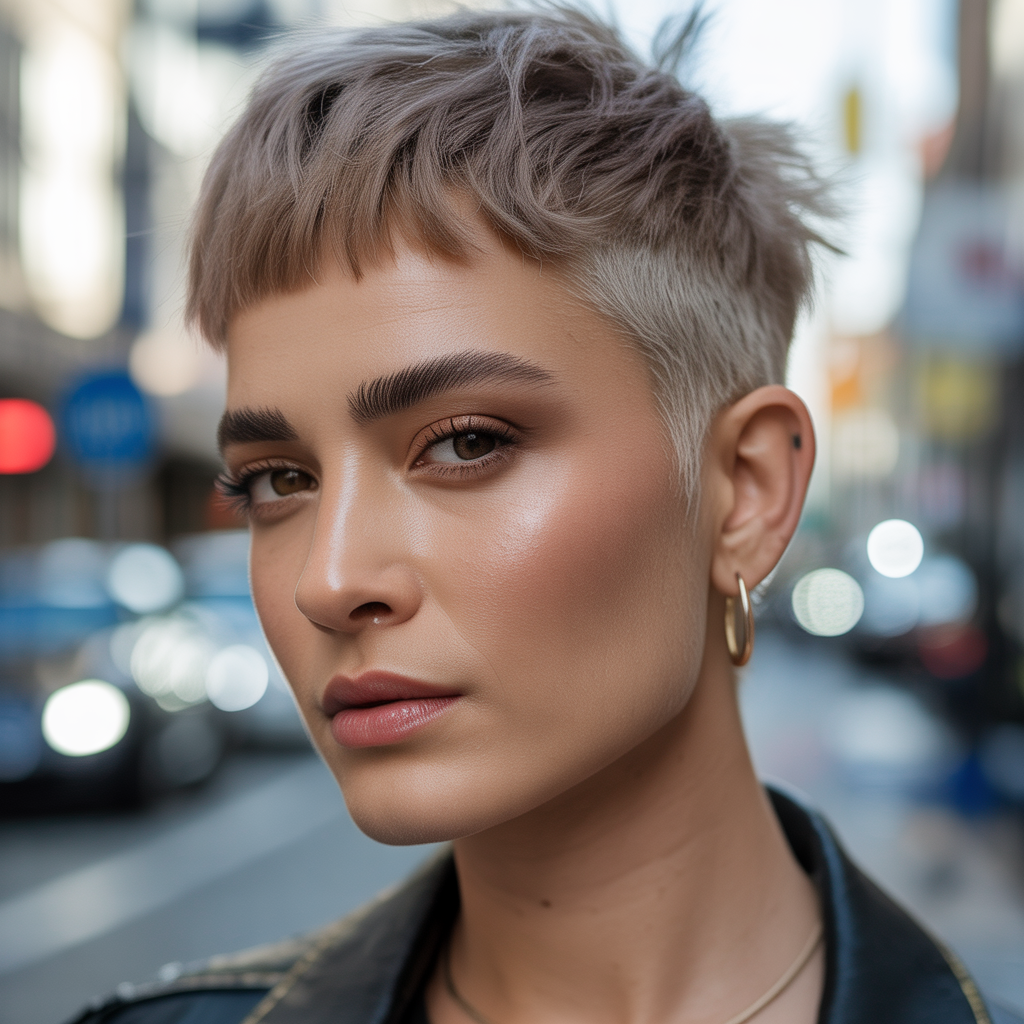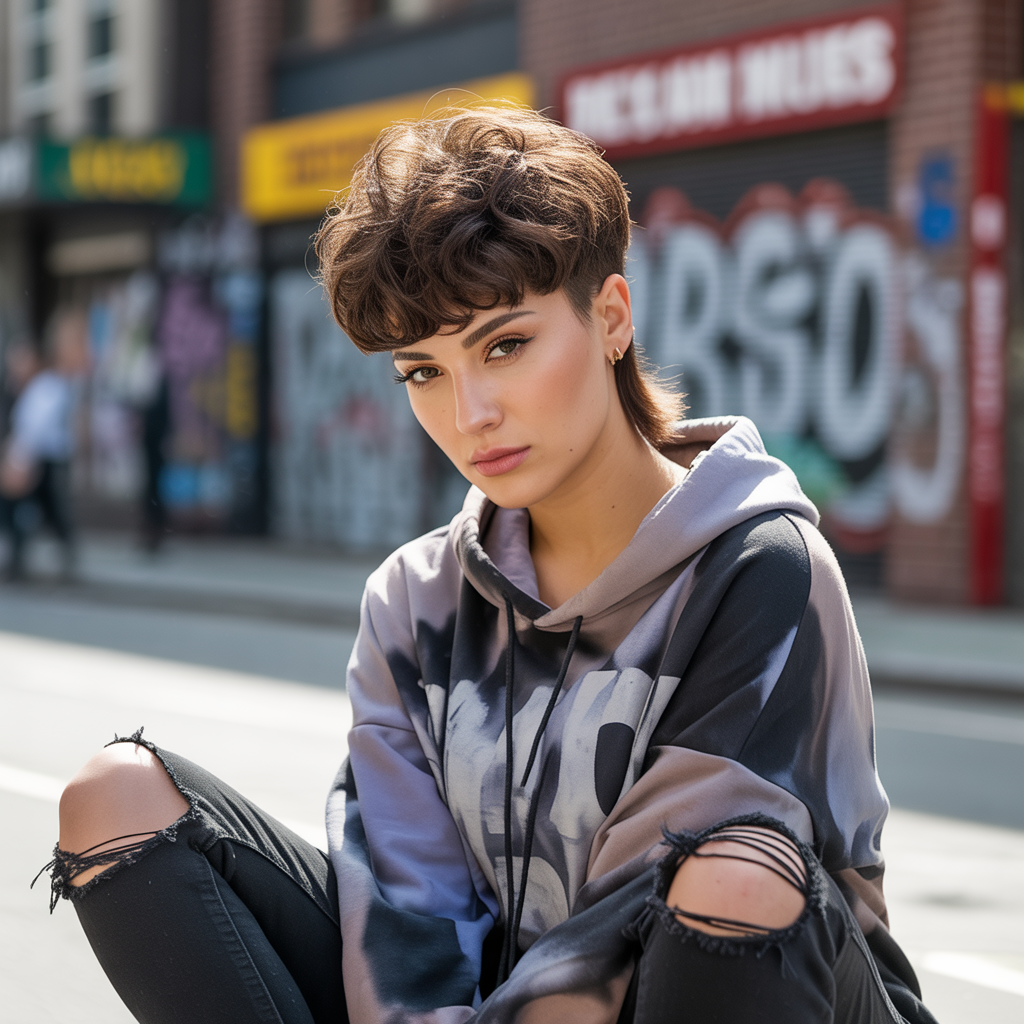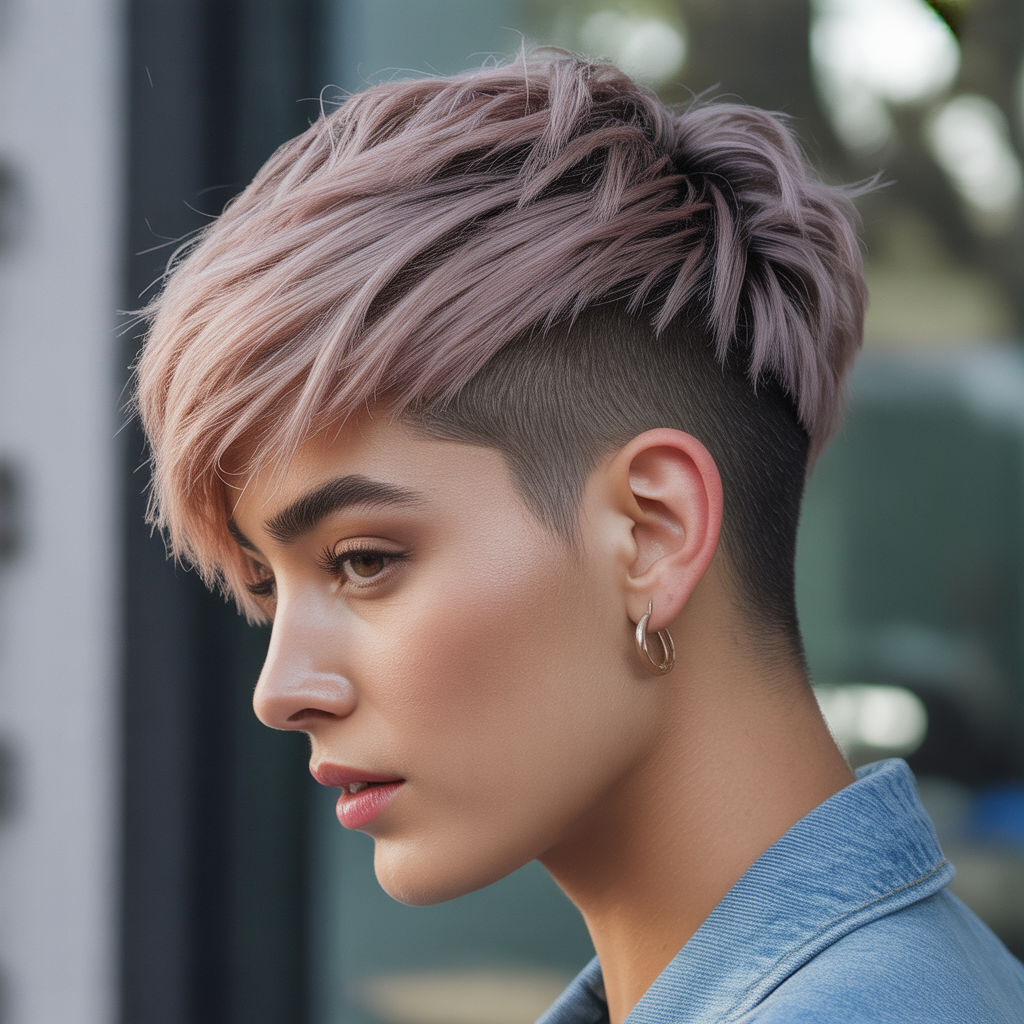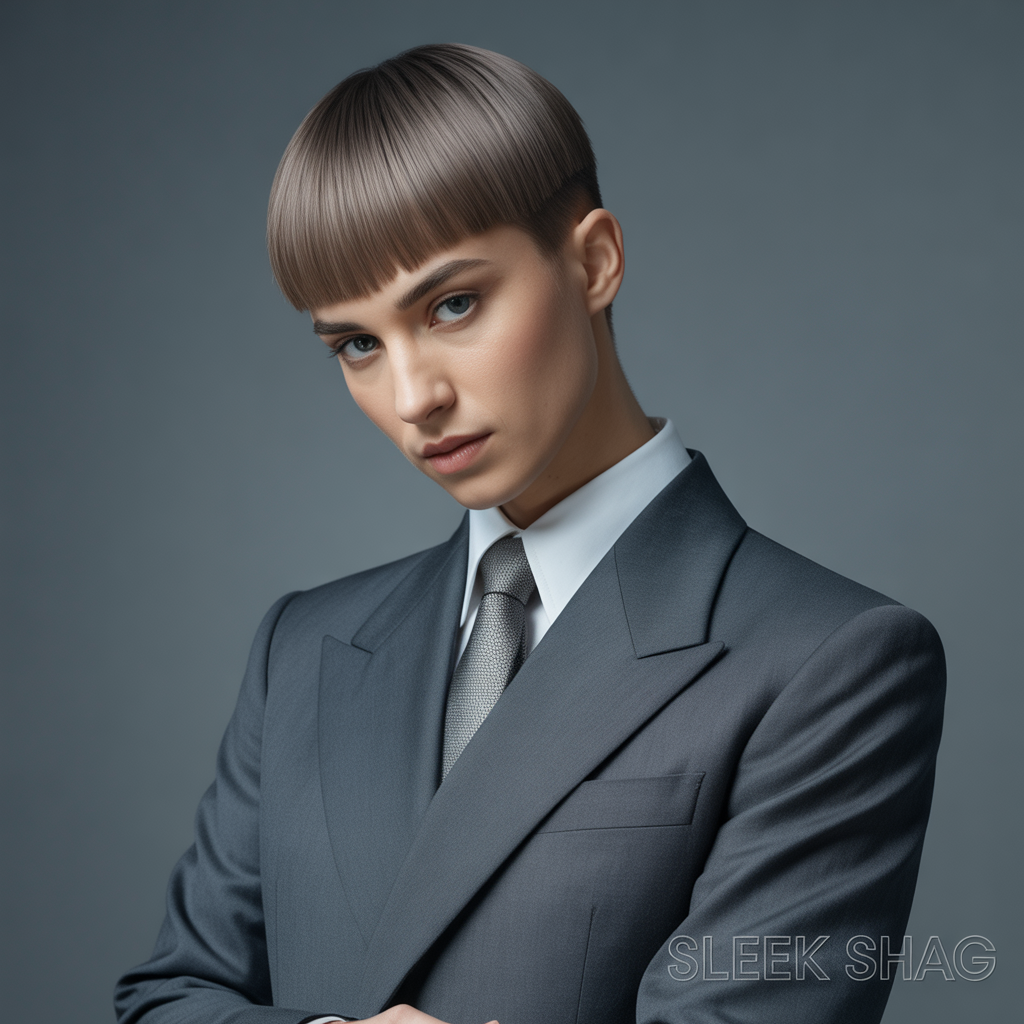Short Shaggy Hair Guide: Cuts, Styling & Maintenance
Short shaggy hair keeps coming back because it balances edge with ease — it’s messy without looking careless, textured without feeling fussy. Whether you want something soft and feminine, rock-and-roll cool, or office-ready with movement, the shag formula (layers + texture + intentional mess) adapts beautifully to different face shapes, hair densities, and lifestyles. Below are 15 fresh ideas for short shaggy hair, each with styling tips, who it flatters, and low-effort maintenance notes so you can pick one that fits your routine.
Edgy Short Shag with Micro Bangs

A cropped shag with very short (micro) bangs frames the face and draws attention to the eyes. The contrast between the textured top and short fringe creates an intentionally rebellious, fashion-forward look. Best for oval and heart shapes. Style with a light pomade or texturizing cream and a quick blow-dry with your fingers for lived-in separation. Trim bangs every 3–5 weeks to keep the shape sharp.
Layered Bob Shag

This blends a classic bob’s silhouette with shaggy layering through the crown and ends. The result is a tidy length with playful movement—perfect for someone who wants moderate structure plus texture. Ideal for fine to medium hair because the layers add perceived volume. Use a root-lift spray and a round brush at the roots, then tousle with salt spray for the signature ragged finish.
Tousled Pixie Shag

A pixie cut with choppy, unequal layers across the top gives a tousled vibe without much effort. It’s especially flattering for people with strong cheekbones and short necklines. Use a small amount of cream wax to separate pieces and add shine. The short length means low washing and quick styling—great for busy mornings.
Curtain-Like Shag with Face-Framing Layers

Longer pieces at the front create a curtain effect that softens the face. The rest of the haircut stays cropped and textured. This version works well for round and square faces as it visually lengthens the face. Blow dry with a round brush to encourage the front pieces to sit away from the face, then finish with lightweight hairspray.
Shaggy Mullet (Modern Revival)

Think: business in the front, party in the back—only updated. Short, textured layers at the crown with slightly longer, feathered length at the nape give movement and attitude. This style flatters medium-to-thick hair and people who like bold, fashion-forward looks. Use a sea salt spray to emphasize the feathered ends and scrunch with your hands while air-drying.
Choppy Shag with Blunt Ends

Contrast is the point here: blunt, even ends with choppy interior layers for texture. The bluntness adds weight and modernity while internal layers keep the style from looking heavy. Great on straight to slightly wavy hair. Heat-style the ends straight for a sleek contrast or rough up with a matte paste for a grungier finish.
Soft Shag with Subtle Face Layers

If you want texture but prefer a softer, more romantic appearance, keep the layers subtle and the ends feathered. Face-softening pieces blend into the rest of the hair rather than standing out. This suits fine hair because the gentle layering creates movement without removing too much length. Use volumizing mousse at damp roots and diffuse to keep the airy look.
Side-Swept Shag with Deep Part

A deep side part changes the entire silhouette—lift at the roots and heavier, asymmetric fringe on one side create a flattering, glamorous effect. This is excellent for those who want to conceal a wider forehead or highlight a cheekbone. Finish by smoothing the part side with a light serum so the textured layers still read soft.
Curly/Coily Short Shag

Shaggy cuts aren’t only for straight hair—curly and coily textures come alive with well-placed short layers that prevent a triangular silhouette and add definition. Keep the crown layered for lift, and shape the front pieces to frame the face. Use a leave-in conditioner and curl cream to define coils; avoid over-brushing so texture remains intact.
Feathered Short Shag

Feathering is the subtle cousin of shagging: thin, tapered layers that flick away from the face. This works beautifully for people who prefer a less aggressive texture. It’s highly wearable in professional settings and still gives you the movement shag styles are known for. A flat iron used sparingly to bend the ends outward adds polish.
Blunt Fringe + Shaggy Crown

Pairing a heavier, blunt fringe with a shaggy, feathered crown creates a modern juxtaposition that’s both chic and a little bit punk. The fringe anchors the look, while the shag keeps it playful. Regular fringe trims are necessary to maintain the contrast; otherwise, maintenance is minimal.
Shag with Undercut Accent

For a daring twist, add a subtle undercut at the nape or behind one ear while keeping the top layers shaggy. The undercut reduces weight and adds edge without committing to a full buzz. This works well for thick hair that needs de-bulking. Style by sweeping the top layers over the undercut for a surprising peek of contrast.
Short Shag with Soft Highlights

Dimension emphasizes texture—soft, face-framing highlights or babylights enhance the choppy layers and make movement more visible. Choose color tones close to your base for a natural effect, or go bold with contrasting color to highlight each layer. Use a color-safe shampoo and gloss treatment to preserve shine.
Sleek Shag with Polished Ends

If you prefer a refined appearance, the shag can be polished: smooth the top and add sharp, textured ends. This hybrid is ideal for those who want the style to read professional yet modern. Use a heat protectant and a straightener to smooth the crown, then a small amount of wax on the tips to separate them.
Low-Maintenance Bedhead Shag

The classic “woke-up-like-this” look. Cut with lots of short pointy layers to encourage natural separation; style by scrunching in a small quantity of salt spray or texturizer and letting it air-dry. This option is perfect if your routine is time-poor—minimal heat, minimal products, maximum cool.
How to Choose the Right Short Shag for Your Face Shape and Hair Type
Pick a shag variation that complements your natural attributes. If you have a round face, opt for longer face-framing layers or a deep side part to create elongation. Square faces benefit from softer, feathered layers that soften strong jaws. Fine hair thrives with shorter layers at the crown for lift; thick hair does well with strategic razoring to remove bulk and reveal movement. Curly textures require a stylist who understands curl dynamics—cut dry or with curl pattern in mind to avoid surprises.
Styling and Product Tips That Actually Work
- For natural texture: sea salt spray or a spray texturizer on damp hair, then scrunch or diffuse.
- For separation and hold: lightweight paste or cream works better than heavy wax; apply to mid-lengths and ends.
- Volume without crunchy residue: root-lifting mousse with a cool blast from your dryer.
- Night routine: sleep on a silk or satin pillowcase to protect the cut and reduce frizz.
- Regular trims: shag looks intentional when kept tidy—visit your stylist every 6–10 weeks depending on how fast your hair grows.
Maintenance: What to Expect
Short shaggy hair generally requires more frequent trims than longer cuts if you want to maintain the shape (every 6–8 weeks for shorter shags, 8–12 for slightly longer versions). Color and textured styles might need extra upkeep. On the daily front, most shags are forgiving—a few finger-strokes, a spritz of texture spray, and you’re out the door.
Frequently Asked Questions (Reality-Based Searches People Actually Ask)
How do I style short shaggy hair to look intentional, not messy?
Use a small amount of product—texturizing spray, cream paste, or sea salt spray—and work it through mid-lengths to ends. Focus on lifting roots slightly and separating pieces with your fingers. A quick diffuse or blow dry with fingers will create texture that appears styled, not accidental.
Will a short shag work on fine hair?
Yes. Fine hair benefits from shorter layers at the crown that create lift and movement. Avoid over-thinning with razors; instead, ask for layering that adds shape without removing all the weight.
Can I air-dry a shag, or do I need heat tools?
You can absolutely air-dry a shag. Apply a texturizing or sea salt spray to damp hair and scrunch as it dries. For a sleeker finish, use a blow dryer and round brush on the crown, then tousle the rest.
How often should I trim my shag to keep the shape?
Shorter shags should be trimmed every 6–8 weeks to maintain the textured silhouette. Longer shag bobs can stretch to 8–12 weeks. If you have bangs or micro fringes, expect more frequent trims.
What is the best product for short shaggy hair that’s frizz-prone?
A lightweight anti-frizz serum applied sparingly to mid-lengths and ends after styling will help—follow with a flexible-hold hairspray if needed. For curly shags, a creamy leave-in and gel mix will define curls without making them crunchy.
Final Thoughts / Conclusion
Short shaggy hair is a brilliant marriage of low maintenance and high personality. With countless variations—from pixie-length messiness to polished, feathered bobs—there’s a shag for nearly every face shape and lifestyle. The keys are choosing the right variation for your hair type, trusting a stylist who understands texture, and adopting a few simple products and trims to keep the movement alive. If you want a bold, modern change that still feels easy to live with, a short shag could be your perfect haircut






